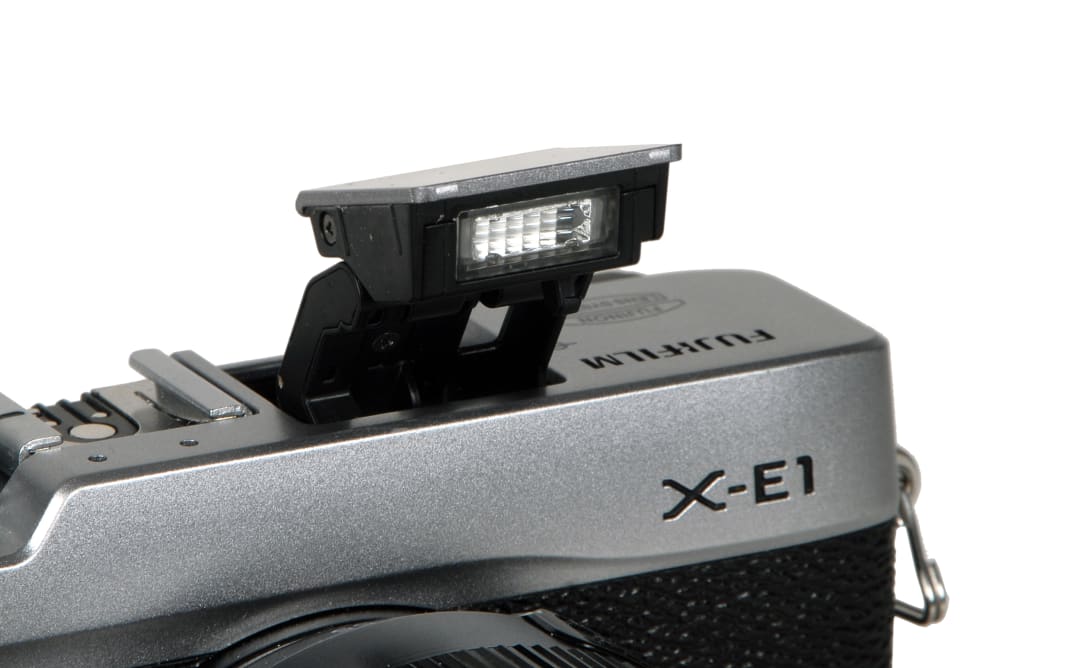Design & Usability
We're not exaggerating when we say that the X-E1 is basically a smaller, more affordable version of the X-Pro1. Just about every question we asked at the Fujifilm booth at Photokina was answered with, "Yes, that is also the same as the X-Pro1." (Read that in a German accent.)
The lens mount, button layout, and general menu design on the X-E1 is basically the same as its bigger brother. The hook, though, is the 2.36-million dot OLED electronic viewfinder. This new unit is a massive improvement 1.44-million dot LCD EVF found in the X-Pro1. Manual focus is pretty easy with such a responsive, high-quality screen, though a focus peaking feature would really seal the deal; such a feature was rumored to be included on the camera, but Fuji product managers sadly confirmed that it is not. At least you'll never have to deal with small framing boxes in the OVF at longer focal lengths. The LCD is slightly smaller (2.8 inches) and lower-res (460k pixels), but the sharp quality of the EVF is a fair trade.
The hybrid finder on the X-Pro1 is nice in theory because people love OVFs, and they get to feel like a jet pilot or the Terminator with the overlaid heads-up display. It's been fine in practice, too, because X-mount lenses so far have been relatively wide primes (though that's debatable with the 60mm macro). But now that the XF family has expanded into zoom-lens territory with the 18-55mm f/2.8-4 lens, with narrower focal lengths rumored to follow, the optical finder is more of a liability than an asset—it's one more feature to turn off.
The X-E1 body also drops some substantial bulk—it's still too big for a pocket, but it's smaller and lighter. Handling is similar, too. It's light for its size and has nothing resembling an ergonomic design; it's old school all the way. It carries a pop-up flash, as well as a hot shoe. Dial-based operation is still in full-effect, with shutter-speed and exposure dials on the body, and the aperture ring on the lenses. There's no standalone mode dial anywhere. The X-E1 menu system is the same as the X-Pro1, with the nimble Q menu carried over as one of the most helpful interfaces on the market. Unfortunately there's one other interface-related quibble that's also been carried over—you'll still need to manually activate macro mode for close focusing, even if you're using a dedicated X-mount macro lens.
Operational speed continues to be an issue with the X-series. The contrast-detection autofocus (in a 49-point matrix) is a touch quicker than it was on the X-Pro1, but still relatively slow, and not always spot-on reliable. Start-up times seem to have improved, and burst shooting is a respectable 6fps, which is nice. But because of the AF speeds, the X-E1 won't be known as an action camera. If your targets can hold still, you'll do fine.
{{photo_gallery "FI Front Photo", "FI Back Photo", "FI Left Photo", "FI Right Photo", "FI Top Photo", "FI Bottom Photo", "FI Lens Photo", "FI Lens Mount Photo", "FI Viewfinder Photo", "FI LCD Photo", "FI Flash Photo", "FI Battery Photo", "FI Media Photo", "FI Ports Photo 1", "FI Ports Photo 2", "FI Handling Photo 1", "FI Handling Photo 2", "FI Ease OF Use Photo", "FI Auto Mode Photo", "FI Manual Controls Photo"}}
Features
{{section_header}}{{section.name}}{{/section_header}}
Again, most features have been carried over from the X-Pro1; the X-E1 is an advanced camera for enthusiasts who want a lot of fine control. It uses the same 16.3 megapixel APS-C sensor with a non-conventional color-filter array and no low-pass filter, so image quality should be identical. The film simulation (color profile) modes are here as well. ISO stretches from 100 to 25,600. RAW capture is supported, of course. White balance can be fine-tuned. Color, tone, and sharpness are adjustable and there are plenty of bracketing options. There's a motion-panorama mode, too.
Video is still 1080/24p; while it's never been Fuji's strong suit, they've gone the extra mile to include a microphone jack. The mic level is adjustable, and a few color profiles work with video mode as well.
The X-E1 will come in a kit configuration with the new 18-55mm f/2.8-4 lens. It's the first zoom lens for the XF-mount, and works a little bit differently from the others in the family. It has no f-stop markings on the aperture ring, which is fully electronic (like the focusing ring); instead, there's a switch to toggle between auto and manual aperture modes. In manual aperture mode, the aperture ring turns freely, and the setting is displayed on the rear LCD or in the EVF. It also has an AF/MF toggle, as expected.

Conclusion
{{section_header}}{{section.name}}{{/section_header}}
We previewed the X-Pro1 last January, and fully reviewed it in May. We've always had a great time with that camera, and learned to love it, even with its quirks.
But in the time that we spent with the X-E1 on the Photokina floor, it stood out to us as a potentially better camera than the X-Pro1, regardless of price. It's a newer model so it's a touch quicker, and we have no reason to believe that performance is otherwise different from the X-Pro1—pictures should still be razor sharp, and it comes with access to a great and ever-growing family of glass. The 18-55mm f/2.8-4 bundled lens is brighter than the usual f/3.5-5.6 you get from most kits, too, and cuts down on the buy-in price for the XF system.
And mainly, the OLED EVF is excellent. It's on par with the best on the market—the Sony A77 springs to mind as a comparison point. Optical finders are fetishized, but in retrospect, the OVF on the X-Pro1 can be seen as more of a distraction than a helpful feature in many cases. The X-E1 is arguably better off for going electronic-only—if Fujifilm can implement focus peaking through a firmware update, it'll be a slam dunk.
We're looking forward to getting the X-E1 into our labs for testing and into our camera bags for some serious shooting. There's no release date pinned down yet, but it'll be available in silver and black, $999 for the body only or $1,399 with the 18-55mm lens. It's a little steep, but in the same wheelhouse as cameras like the Sony NEX-7 and Olympus OM-D E-M5.
Introduction
It feels redundant to re-introduce the Fujifilm X Series at this point. At Photokina 2010, Fuji debuted the X100, a fixed-lens camera with a big sensor and a groundbreaking optical/electronic hybrid viewfinder. It was Fuji's biggest move in quite some time, and it set them up for a big run over these last couple of years.
Since the last show in Cologne, they've produced a line of mostly successful high-end cameras starting with that X100, followed by the X10 compact and the interchangeable-lens X-Pro1, with which they also introduced the X mount and the XF family of lenses. All Fuji cameras have quirks, and the X-Pro1 was no exception, but it earned plenty of kudos for its pin-sharp image quality and its hybrid viewfinder, carried over from the X100.
Now Fuji has introduced the X-E1, as close as they've come to a mass-market mirrorless compact system camera so far. It's basically the X-Pro1 without the hybrid finder, and at a significantly lower price: $999 for the X-E1 body, compared to $1,699 for the X-Pro1. We're not the only ones thinking it: The X-E1 looks to be a much better deal than its predecessor.
Specs
{{manufacturer_specs_table}}
Meet the tester
Liam manages features and news coverage for Reviewed.com. Formerly the editor of the DigitalAdvisor network, he's covered cameras, TVs, personal electronics, and (recently) appliances. He's a native Bostonian and has played in metal bands you've never heard of.
Checking our work.
Our team is here for one purpose: to help you buy the best stuff and love what you own. Our writers, editors, and lab technicians obsess over the products we cover to make sure you're confident and satisfied. Have a different opinion about something we recommend? Email us and we'll compare notes.
Shoot us an email


